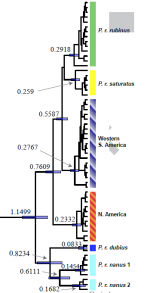Some recent publications provide informations about genetic and taxonomy of Galapagos passerine species, but only two of them lead to taxonomic revisions and elevation of some subspecies to species rank, important decisions for conservation of this unique species facing many threats particulary Philornis downsi.
# Evolution of Darwin's Finches and Their Beaks Revealed by Genome Sequencing S Lamichhaney et al. Nature 518 (7539) (2015):
Geospiza acutirostris Ridgway, 1894 Vulnerable
Geospiza septentrionalis Rothschild and E. J. O. Hartert, 1899 Vulnerable
Geospiza conirostris Ridgway, 1890 (monotypic) Vulnerable
Geospiza propinqua Ridgway, 1894 Vulnerable
# Carmi, O., Witt, C.C., Jaramillo, A., Dumbacher, J.P., Phylogeography of the Vermilion
Flycatcher species complex: multiple speciation events, shifts in migratory behavior, and an apparent extinction of
a Galápagos-endemic bird species, Molecular Phylogenetics and Evolution (2016):
Pyrocephalus dubius Gould, 1839 EXTINCT (too late !!!)
But some data for other publications are without any taxonomic and conservation decisions :
# It’s also probably too late for Certhidea fusca ridgwayi from Floreana, most divergent subspecies could merit elevation to species rank according to
Extinction behind our backs: the possible fate of one of the Darwin’s finch species on Isla Floreana, Galapagos P.R. Grant, B.R. Grant, K. Petren, L.F. Keller Biological Conservation 122 (2005) 499–503
and
Habitat selection and ecological speciation in Galápagos warbler finches (Certhidea olivacea and Certhidea fusca)
Brandon Tonnis, Peter R Grant, B. Rosemary Grant, Kenneth Petren Published 22 April 2005
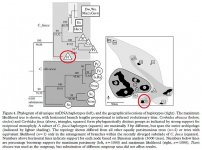
# Twelve years later, no name for divergent population of Certhidea fusca from Los Hermanos (=Crossman), small islands south-east of Isabela according to
Habitat selection and ecological speciation in Galápagos warbler finches (Certhidea olivacea and Certhidea fusca)
Brandon Tonnis, Peter R Grant, B. Rosemary Grant, Kenneth Petren Published 22 April 2005
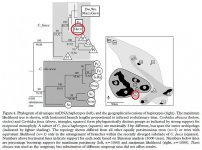
# Another extinct species not recognized, the extinct Floreana population of Geospiza difficilis is distinct and could merit elevation to species rank as Geospiza nebulosa (Gould, 1837), the first extinct Galapagos bird species, according to
2010 Multilocus genotypes from Charles Darwin’s finches: biodiversity lost since the voyage of the Beagle
Kenneth Petren1,*, Peter R. Grant2, B. Rosemary Grant2, Andrew A. Clack1,† and Ninnia V. Lescano1:
“The sharp-beaked ground finch (G. difficilis) is
notable for several reasons. Lack (1947) could not discern
where to place this species on an evolutionary
tree, since island populations varied widely, and their
traits were shared with differing subsets of other
species. Based on their unique beak shape, G. difficilis
populations form a natural group (Schluter et al. 1991;
Grant 1999). Genetically, G. difficilis is highly structured,
with genetic differences among populations
that surpass genetic differences among many other
species (Grant et al. 2000; Petren et al. 2005). The current
study supports the notion that two additional
populations of this highly divergent species existed
on Floreana and Isabela. The genetic distinctness of
the Floreana specimen supports Steadman’s (1986)
attribution of fossil remains found on this island to
G. difficilis. The genetic distinctness of these birds
from other G. difficilis and other species may be substantial
if the single specimens are a reasonable
representation of the sampled populations (figure 4).”
# Geospiza magnirostris from Darwin and Wolf islands, and from Floreana and San Cristobal are distinct from populations of other islands, Geospiza magnirostris darwini (formerly Geospiza conirostris darwini) from remote Darwin and Wolf could merit elevation to species rank, and populations from other islands are distinct from extinct Floreana and San Cristobal and could merit recognition of the subspecies Geospiza magnirostris strenua (Gould, 1837) according to
2010 Multilocus genotypes from Charles Darwin’s finches: biodiversity lost since the voyage of the Beagle
Kenneth Petren1,*, Peter R. Grant2, B. Rosemary Grant2, Andrew A. Clack1,† and Ninnia V. Lescano1:
“(a) Genetic distinctness of G. magnirostris populations
The four populations of large ground finches
(G. magnirostris) from museum collections were genetically
distinct from eight other field-sampled
populations of G. magnirostris. Genetic distances
among previously sampled reference populations
were significantly lower than the distances between
the four museum populations and the rest (table 1).
The first two principal component axes depict
Darwin and Wolf as more distinct than the San
Cristo´bal and Floreana populations (figure 2), but
this is only part of the story. Nei’s genetic distance
captures the distinct nature of the giant forms from
San Cristo´bal and Floreana collected by Darwin
(table 1). Large ground finches from the extremely
remote (and neighbouring) islands of Darwin and
Wolf had lower (and identical) expected heterozygosities
than the Floreana and San Cristo´bal
populations, as would be expected owing to their
small size and isolation from immigrant gene flow.
(b) Genetic affinity of G. magnirostris individuals
The 1835 specimens considered to be from San
Cristo´bal (n ¼ 6) and Floreana (n ¼ 3) appeared to
form natural groupings. Likelihood scores for crossmembership
in other populations were much lower
than for the specified population (figure 3). One
G. magnirostris of questionable origin (1m) appears to
be from Santiago (table 2). This bird was earlier
thought to be from San Cristo´bal before Sulloway
(1982) showed that it is more typical morphologically
of the Santiago population. Another G. magnirostris of
unknown origin appears to be from Floreana (3m),
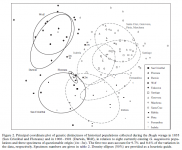 while a third (2m) could not be classified.”
while a third (2m) could not be classified.”
# Two more subspecies for Mimus parvulus ? M.p.bindloei (Ridgway, 1894) from Marchena distinct from M.p.personatus from Santiago, Rabida and Pinta, and M.p.dierythrus (Heller and Snodgrass, 1901) from Santa Cruz and Baltra distinct from M.p.parvulus from Isabela and Fernandina according to
2010 Differentiation with drift: a spatio-temporal genetic analysis of Gala´pagos mockingbird populations (Mimus spp.) Paquita E. A. Hoeck1,*, Jennifer L. Bollmer2,†, Patricia G. Parker2 and Lukas F. Keller1
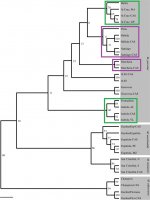
# Mimus parvulus bauri from Genovesa could merit elevation to species rank according to
2013 Hybrid ancestry of an island subspecies of Galápagos mockingbird explains discordant gene trees
Pirmin Nietlisbach a,⇑, Peter Wandeler a, Patricia G. Parker b, Peter R. Grant c, B. Rosemary Grant c,Lukas F. Keller a, Paquita E.A. Hoeck a,1
“The morphology of Genovesa mockingbirds is distinct, albeit
not exactly intermediate between their parent species. The distinctiveness
of Genovesa mockingbirds has also been recognised by
systematics. The first description of the Genovesa mockingbird
considered it a new species (Nesomimus bauri; Ridgway, 1894),
but nowadays it is treated as subspecies M. parvulus bauri (Cody,
2005; Clements et al., 2012). Irrespective of its taxonomic label,
the Genovesa mockingbird is a lineage of mixed genetic ancestry,
but it remains difficult to judge to what extent the here described
ancient introgression contributed to the morphological distinctiveness
of Genovesa mockingbirds. If morphological distinctiveness
and reproductive isolation of Genovesa mockingbirds from both
parental species was increased by hybridization, this case could
be considered one of incipient homoploid hybrid speciation.
Continuing divergence and speciation of Genovesa mockingbirds
may be facilitated by their geographic isolation from both parental
species (Buerkle et al., 2000; Duenez-Guzman et al., 2009), but
their current degree of reproductive isolation remains to be
studied. »
# Certhidea fusca cinerascens could merit species rank according to
Evolution of Darwin's Finches and Their Beaks Revealed by Genome Sequencing S Lamichhaney et al. Nature 518 (7539) (2015):
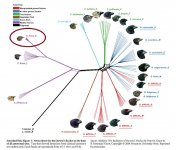
# and the more concern, the non-taxonomic recognition of the two distinct clades of Pyrocephalus nanus VULNERABLE, subspecies or species names is available for them and the conservation of this (these) species is urgent !,
Clade 1 : Pyrocephalus nanus or P.n.nanus, Pinta, Marchena, Santiago, Santa Cruz (severe decline) and formerly Santa Fé,
Clade 2: Pyrocephalus carolensis or P.n.carolensis (Ridgway,1896), Fernandina, Isabela (decline), probably extinct on Floreana,
according to
- Carmi, O., Witt, C.C., Jaramillo, A., Dumbacher, J.P., Phylogeography of the Vermilion
Flycatcher species complex: multiple speciation events, shifts in migratory behavior, and an apparent extinction of
a Galápagos-endemic bird species, Molecular Phylogenetics and Evolution (2016)
- GALAPAGOS REPORT 2011-2012 BIODIVERSITY AND ECOSYSTEM RESTORATION GONE, GONE … GOING: The FATE OF THE VERMILION FLYCATCHER ON DARWIN’S ISLANDS GODFREY MERLEN
- LANDBIRD CONSERVATION PLAN: STRATEGIES FOR REVERSING THE DECLINE OF PASSERINE BIRDS ON THE GALAPAGOS ISLANDS
# Evolution of Darwin's Finches and Their Beaks Revealed by Genome Sequencing S Lamichhaney et al. Nature 518 (7539) (2015):
Geospiza acutirostris Ridgway, 1894 Vulnerable
Geospiza septentrionalis Rothschild and E. J. O. Hartert, 1899 Vulnerable
Geospiza conirostris Ridgway, 1890 (monotypic) Vulnerable
Geospiza propinqua Ridgway, 1894 Vulnerable
# Carmi, O., Witt, C.C., Jaramillo, A., Dumbacher, J.P., Phylogeography of the Vermilion
Flycatcher species complex: multiple speciation events, shifts in migratory behavior, and an apparent extinction of
a Galápagos-endemic bird species, Molecular Phylogenetics and Evolution (2016):
Pyrocephalus dubius Gould, 1839 EXTINCT (too late !!!)
But some data for other publications are without any taxonomic and conservation decisions :
# It’s also probably too late for Certhidea fusca ridgwayi from Floreana, most divergent subspecies could merit elevation to species rank according to
Extinction behind our backs: the possible fate of one of the Darwin’s finch species on Isla Floreana, Galapagos P.R. Grant, B.R. Grant, K. Petren, L.F. Keller Biological Conservation 122 (2005) 499–503
and
Habitat selection and ecological speciation in Galápagos warbler finches (Certhidea olivacea and Certhidea fusca)
Brandon Tonnis, Peter R Grant, B. Rosemary Grant, Kenneth Petren Published 22 April 2005

# Twelve years later, no name for divergent population of Certhidea fusca from Los Hermanos (=Crossman), small islands south-east of Isabela according to
Habitat selection and ecological speciation in Galápagos warbler finches (Certhidea olivacea and Certhidea fusca)
Brandon Tonnis, Peter R Grant, B. Rosemary Grant, Kenneth Petren Published 22 April 2005

# Another extinct species not recognized, the extinct Floreana population of Geospiza difficilis is distinct and could merit elevation to species rank as Geospiza nebulosa (Gould, 1837), the first extinct Galapagos bird species, according to
2010 Multilocus genotypes from Charles Darwin’s finches: biodiversity lost since the voyage of the Beagle
Kenneth Petren1,*, Peter R. Grant2, B. Rosemary Grant2, Andrew A. Clack1,† and Ninnia V. Lescano1:
“The sharp-beaked ground finch (G. difficilis) is
notable for several reasons. Lack (1947) could not discern
where to place this species on an evolutionary
tree, since island populations varied widely, and their
traits were shared with differing subsets of other
species. Based on their unique beak shape, G. difficilis
populations form a natural group (Schluter et al. 1991;
Grant 1999). Genetically, G. difficilis is highly structured,
with genetic differences among populations
that surpass genetic differences among many other
species (Grant et al. 2000; Petren et al. 2005). The current
study supports the notion that two additional
populations of this highly divergent species existed
on Floreana and Isabela. The genetic distinctness of
the Floreana specimen supports Steadman’s (1986)
attribution of fossil remains found on this island to
G. difficilis. The genetic distinctness of these birds
from other G. difficilis and other species may be substantial
if the single specimens are a reasonable
representation of the sampled populations (figure 4).”
# Geospiza magnirostris from Darwin and Wolf islands, and from Floreana and San Cristobal are distinct from populations of other islands, Geospiza magnirostris darwini (formerly Geospiza conirostris darwini) from remote Darwin and Wolf could merit elevation to species rank, and populations from other islands are distinct from extinct Floreana and San Cristobal and could merit recognition of the subspecies Geospiza magnirostris strenua (Gould, 1837) according to
2010 Multilocus genotypes from Charles Darwin’s finches: biodiversity lost since the voyage of the Beagle
Kenneth Petren1,*, Peter R. Grant2, B. Rosemary Grant2, Andrew A. Clack1,† and Ninnia V. Lescano1:
“(a) Genetic distinctness of G. magnirostris populations
The four populations of large ground finches
(G. magnirostris) from museum collections were genetically
distinct from eight other field-sampled
populations of G. magnirostris. Genetic distances
among previously sampled reference populations
were significantly lower than the distances between
the four museum populations and the rest (table 1).
The first two principal component axes depict
Darwin and Wolf as more distinct than the San
Cristo´bal and Floreana populations (figure 2), but
this is only part of the story. Nei’s genetic distance
captures the distinct nature of the giant forms from
San Cristo´bal and Floreana collected by Darwin
(table 1). Large ground finches from the extremely
remote (and neighbouring) islands of Darwin and
Wolf had lower (and identical) expected heterozygosities
than the Floreana and San Cristo´bal
populations, as would be expected owing to their
small size and isolation from immigrant gene flow.
(b) Genetic affinity of G. magnirostris individuals
The 1835 specimens considered to be from San
Cristo´bal (n ¼ 6) and Floreana (n ¼ 3) appeared to
form natural groupings. Likelihood scores for crossmembership
in other populations were much lower
than for the specified population (figure 3). One
G. magnirostris of questionable origin (1m) appears to
be from Santiago (table 2). This bird was earlier
thought to be from San Cristo´bal before Sulloway
(1982) showed that it is more typical morphologically
of the Santiago population. Another G. magnirostris of
unknown origin appears to be from Floreana (3m),
 while a third (2m) could not be classified.”
while a third (2m) could not be classified.”# Two more subspecies for Mimus parvulus ? M.p.bindloei (Ridgway, 1894) from Marchena distinct from M.p.personatus from Santiago, Rabida and Pinta, and M.p.dierythrus (Heller and Snodgrass, 1901) from Santa Cruz and Baltra distinct from M.p.parvulus from Isabela and Fernandina according to
2010 Differentiation with drift: a spatio-temporal genetic analysis of Gala´pagos mockingbird populations (Mimus spp.) Paquita E. A. Hoeck1,*, Jennifer L. Bollmer2,†, Patricia G. Parker2 and Lukas F. Keller1

# Mimus parvulus bauri from Genovesa could merit elevation to species rank according to
2013 Hybrid ancestry of an island subspecies of Galápagos mockingbird explains discordant gene trees
Pirmin Nietlisbach a,⇑, Peter Wandeler a, Patricia G. Parker b, Peter R. Grant c, B. Rosemary Grant c,Lukas F. Keller a, Paquita E.A. Hoeck a,1
“The morphology of Genovesa mockingbirds is distinct, albeit
not exactly intermediate between their parent species. The distinctiveness
of Genovesa mockingbirds has also been recognised by
systematics. The first description of the Genovesa mockingbird
considered it a new species (Nesomimus bauri; Ridgway, 1894),
but nowadays it is treated as subspecies M. parvulus bauri (Cody,
2005; Clements et al., 2012). Irrespective of its taxonomic label,
the Genovesa mockingbird is a lineage of mixed genetic ancestry,
but it remains difficult to judge to what extent the here described
ancient introgression contributed to the morphological distinctiveness
of Genovesa mockingbirds. If morphological distinctiveness
and reproductive isolation of Genovesa mockingbirds from both
parental species was increased by hybridization, this case could
be considered one of incipient homoploid hybrid speciation.
Continuing divergence and speciation of Genovesa mockingbirds
may be facilitated by their geographic isolation from both parental
species (Buerkle et al., 2000; Duenez-Guzman et al., 2009), but
their current degree of reproductive isolation remains to be
studied. »
# Certhidea fusca cinerascens could merit species rank according to
Evolution of Darwin's Finches and Their Beaks Revealed by Genome Sequencing S Lamichhaney et al. Nature 518 (7539) (2015):

# and the more concern, the non-taxonomic recognition of the two distinct clades of Pyrocephalus nanus VULNERABLE, subspecies or species names is available for them and the conservation of this (these) species is urgent !,
Clade 1 : Pyrocephalus nanus or P.n.nanus, Pinta, Marchena, Santiago, Santa Cruz (severe decline) and formerly Santa Fé,
Clade 2: Pyrocephalus carolensis or P.n.carolensis (Ridgway,1896), Fernandina, Isabela (decline), probably extinct on Floreana,
according to
- Carmi, O., Witt, C.C., Jaramillo, A., Dumbacher, J.P., Phylogeography of the Vermilion
Flycatcher species complex: multiple speciation events, shifts in migratory behavior, and an apparent extinction of
a Galápagos-endemic bird species, Molecular Phylogenetics and Evolution (2016)
- GALAPAGOS REPORT 2011-2012 BIODIVERSITY AND ECOSYSTEM RESTORATION GONE, GONE … GOING: The FATE OF THE VERMILION FLYCATCHER ON DARWIN’S ISLANDS GODFREY MERLEN
- LANDBIRD CONSERVATION PLAN: STRATEGIES FOR REVERSING THE DECLINE OF PASSERINE BIRDS ON THE GALAPAGOS ISLANDS
Last edited:




